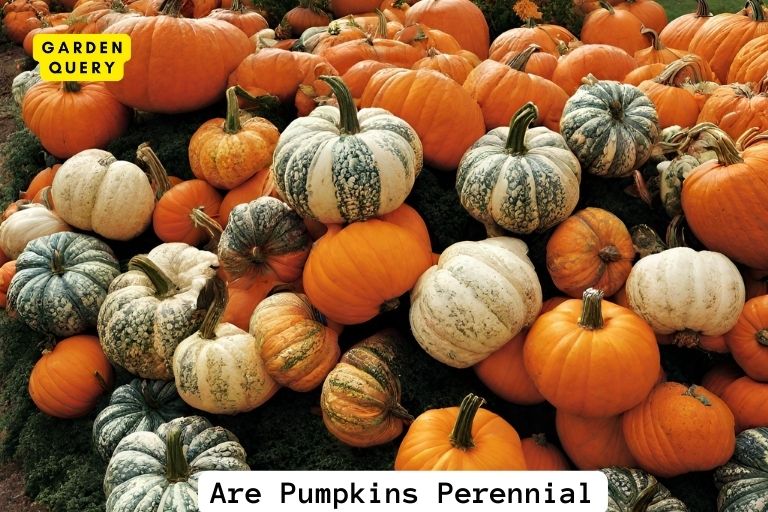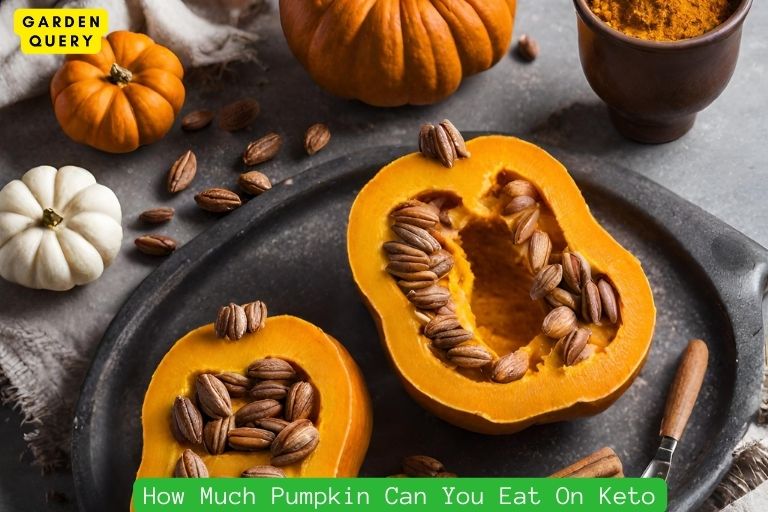How Do Pumpkin Seeds Grow?
Pumpkin seeds grow from the flowers of the pumpkin plant and mature within the pumpkin fruits.
Pumpkin seeds begin their growth within the flowers of the pumpkin plant after successful pollination.
Once the flowers are pollinated, they develop into fruits, commonly known as pumpkins, where the seeds mature. As the pumpkin fruit matures, the seeds inside undergo development and ripening.
When the pumpkin reaches maturity, the seeds are fully formed and can be harvested for planting or consumption.
Each pumpkin contains numerous seeds, encapsulated within the pulp of the fruit, ready for use in various applications.
Key Takeaway
Pumpkin Seeds Grow
Overview of pumpkin seeds and their growth process
In the realm of gardening, few things are as satisfying as growing your own pumpkins from seed.
Not only do you get the pleasure of watching these vibrant orange fruits mature, but you also have the opportunity to harvest the seeds for future planting.

Pumpkin seeds, also known as pepitas, are the key to starting your pumpkin-growing adventure.
They are obtained by removing them from the flesh of the ripe pumpkin and allowing them to dry out. Once dried, these seeds can be stored and used for planting later.
To begin the growth process, it is essential to prepare the soil adequately. Pumpkins thrive in well-draining soil that is rich in organic matter.
Start by loosening the soil and removing any debris or weeds that may hinder growth.
Pumpkin seeds require warmth and moisture to germinate. Plant the seeds about an inch deep into the soil, spacing them a couple of feet apart. Ensure that the planting area receives ample sunlight, as pumpkins are sun-loving plants.
Water the planted seeds regularly, keeping the soil moist but not waterlogged.
Within a couple of weeks, you should start to see small seedlings emerging from the soil. As they grow, provide support for the vines by using stakes or trellises.
With proper care and maintenance, your pumpkin seeds will continue to grow into beautiful pumpkins.
Be sure to water them regularly, especially during dry spells. Monitor for pests and diseases and take appropriate action if necessary.
Read More: Pumpkin
Importance of pumpkin seeds in gardening
Pumpkin seeds are not only crucial for growing pumpkins but also offer numerous benefits to gardeners.
Here are some reasons why pumpkin seeds are important in gardening:
- Cost-effectiveness: By saving and replanting your pumpkin seeds, you eliminate the need to purchase new seeds each season, saving money in the long run.
- Diversity: Growing pumpkins from seed allows you to choose from a wide variety of pumpkin types, sizes, and colors. This allows for a diverse and visually appealing garden.
- Educational value: Planting pumpkin seeds with children or students can be an excellent educational activity. It teaches them about plant life cycles, horticulture, and the importance of nurturing living things.
- Self-sufficiency: By growing your own pumpkins from seed, you become more self-sufficient and less reliant on purchasing produce from the store. This can be a rewarding experience for those looking to be more self-reliant.
As you can see, pumpkin seeds play a vital role in the gardening process. From starting the growth cycle to providing opportunities for cost savings and education, these seeds are a valuable asset to any gardener.
So why not give it a try? Plant some pumpkin seeds in a sunny spot, provide them with the care they need, and soon you’ll be enjoying the fruits of your labor – literally!
Pumpkin Seed Germination
Factors affecting germination of pumpkin seeds
Pumpkin seeds are a popular choice for home gardeners, as they are relatively easy to grow and can produce a bountiful harvest.
Successful germination of pumpkin seeds depends on several factors.
- Temperature: Pumpkin seeds require warm soil temperatures to germinate. The ideal range is between 70-90 degrees Fahrenheit (21-32 degrees Celsius). If the soil is too cold, the seeds may not sprout or may take a longer time to germinate.
- Moisture: Adequate moisture is crucial for seed germination. Pumpkin seeds should be planted in well-draining soil that is kept consistently moist. Avoid overwatering, as this can lead to rotting, but also ensure that the soil does not dry out completely.
- Light: Pumpkin seeds do not require light to germinate. In fact, they actually prefer darkness during the germination process. When planting pumpkin seeds, cover them with about an inch of soil to provide the necessary darkness for successful germination.
Steps to encourage successful germination
To maximize the chances of successful germination and ensure a healthy pumpkin crop, follow these steps:
- Choose quality seeds: Select high-quality pumpkin seeds from a reputable source. Look for seeds that are plump, firm, and free from damage or disease.
- Prepare the soil: Before planting, ensure that the soil is well-prepared by removing any weeds or debris. Loosen the soil to a depth of at least 12 inches and amend with organic matter, such as compost, to improve fertility and drainage.
- Sow the seeds: Plant the pumpkin seeds directly into the prepared soil. Make a small hole about 1-2 inches deep and place one or two seeds in each hole. Space the holes about 2-3 feet apart to allow the plants room to grow.
- Water properly: After planting, water the seeds thoroughly to promote moisture penetration. Then, water regularly to keep the soil evenly moist but not waterlogged. Avoid overhead watering, as this can increase the risk of disease.
- Provide support: As the pumpkin plants grow, they may require support to prevent the vines from sprawling on the ground. Consider using trellises or stakes to keep the plants upright and ensure proper air circulation.
- Monitor for pests and diseases: Regularly inspect the pumpkin plants for signs of pests or diseases, such as powdery mildew or pests like aphids. Take appropriate action if any issues arise to protect the health of the plants.
By paying attention to these factors and following the necessary steps, you can increase the likelihood of successful pumpkin seed germination and enjoy a fruitful harvest. Happy gardening!
Read More: How Are Pumpkins Made?
Pumpkin Seedling Development
Have you ever wondered how those small pumpkin seeds turn into big, beautiful pumpkins?
Well, wonder no more! Let's take a closer look at the stages of pumpkin seedling growth and how to nurture them for healthy development.
Stages of pumpkin seedling growth
- Seed germination: The first stage of a pumpkin seed’s growth begins when it is planted in warm soil. Within a week or two, the seed will germinate, and a tiny sprout will emerge.
- Cotyledon development: As the seedling grows, it will develop its cotyledons, which are the first leaves to appear. These initial leaves serve as the seedling’s food source until it can begin photosynthesis.
- True leaf growth: Following the cotyledons, the pumpkin seedling will produce its true leaves. These leaves look different from the cotyledons and are responsible for the seedling’s ongoing growth.
- Vine development: As the seedling continues to grow, it will produce vines that spread out in search of sunlight. These vines are crucial for the pumpkin’s ability to absorb nutrients and water from the soil.
- Flower production: Once the pumpkin seedling has matured, it will start producing flowers. These flowers are essential for pollination, which is necessary for the development of pumpkins.
Nurturing seedlings for healthy development
To ensure your pumpkin seedlings develop into healthy and robust plants, here are a few tips:
- Provide adequate sunlight: Pumpkin seedlings require at least six hours of direct sunlight each day. Place them in a location where they can receive ample sunlight.
- Water consistently: Keep the soil evenly moist, not saturated, by watering your seedlings regularly. Avoid letting the soil dry out between waterings. However, be careful not to overwater, as this can lead to root rot.
- Control pests and diseases: Monitor your seedlings for signs of pests or diseases, such as aphids or powdery mildew. Take necessary measures, such as using organic pest controls or removing affected leaves, to protect your plants.
- Fertilize as needed: If the soil lacks nutrients, supplement it with organic fertilizers. Follow the instructions on the fertilizer packaging for the appropriate application.
By following these guidelines, you can ensure the healthy development of your pumpkin seedlings and increase the chances of growing big, beautiful pumpkins in your garden.
So grab some seeds, get your hands dirty, and watch as nature works its magic!
Pumpkin Plant Growth
Pumpkin seeds are not only delicious when roasted, but they also have the potential to grow into thriving pumpkin plants.
If you've ever wondered how pumpkin seeds grow and what factors influence their growth, you're in the right place.
Critical factors influencing pumpkin plant growth
- Sunlight: Pumpkins are sun-loving plants that require a minimum of six hours of direct sunlight per day. Lack of sunlight can result in weakened plants with less fruit production.
- Soil: Well-draining soil rich in organic matter is essential for the growth of pumpkin plants. The soil should be loose and fertile to allow for proper root development and nutrient absorption.
- Water: Adequate watering is crucial for pumpkin plant growth. While they don’t like extremely wet conditions, pumpkins require consistent moisture. Water the plants deeply, soaking the soil to a depth of about 6 inches.
- Temperature: Pumpkins are warm-weather plants and thrive in temperatures between 65°F and 85°F (18°C – 29°C). Planting pumpkins too early or too late in the season can hinder their growth.
Caring for pumpkin plants throughout the growing season
- Fertilization: Apply a balanced fertilizer at the time of planting and again when the vines begin to spread. This will provide essential nutrients that promote healthy growth and fruit development.
- Weed control: Keep the area around your pumpkin plants free from weeds to reduce competition for water and nutrients. Mulching can help suppress weed growth and maintain soil moisture.
- Pollination: Pumpkins rely on pollinators, such as bees, to transfer pollen between male and female flowers. To increase the chances of successful pollination, plant flowers that attract pollinators nearby.
- Pest control: Regularly monitor your pumpkin plants for common pests, such as squash bugs or aphids, and take appropriate measures to control infestations. Organic pest control methods, such as handpicking pests or using insecticidal soap, can be effective.
By providing the right growing conditions and proper care, you can enjoy a bountiful harvest of pumpkins.
Choose pumpkin varieties suited to your climate and keep an eye out for any specific recommendations for your region.
Read More: How Are Pumpkins Pollinated?
Pumpkin Seed Harvesting
Pumpkin seeds are not only delicious and nutritious, but they are also fun to grow in your garden.
If you are a gardening enthusiast wondering how pumpkin seeds grow, here are some key points to consider.
Signs of maturity for pumpkin seeds
Knowing when your pumpkin seeds are ripe and ready for harvesting is crucial for a successful harvest.
Here are some signs to look out for:
- Color: When the pumpkin has reached its full maturity, the seeds will turn a dark brown or black color. Avoid picking them too early when they are still green or white.
- Sound: A fully mature pumpkin will produce a hollow sound when tapped. If it sounds solid, the seeds may still need more time to ripen.
- Firmness: Gently press on the pumpkin’s skin. If it feels tough and resistant, it is a good indication that the seeds have reached maturity.
- Drying: The pumpkin vine starts to wither and die as the fruit matures. Once the vine has completely dried up, it is a clear sign that the seeds are ready for harvest.
Methods for harvesting and preparing pumpkin seeds
After identifying that your pumpkin seeds are mature, it’s time to harvest and prepare them.
Follow these steps for a successful harvest:
- Cut: Use a sharp knife or pair of scissors to carefully cut the pumpkin from the vine, leaving a few inches of stem attached.
- Clean: Remove the seeds from the pumpkin pulp by scooping them out with a spoon or your hands. Separate the seeds from the pulp, rinsing them thoroughly under cold water to remove any remaining flesh.
- Dry: Place the seeds in a single layer on a clean towel or parchment paper and allow them to air dry for several days. Stir them occasionally to ensure even drying.
- Roast: Preheat your oven to 300°F (150°C). Toss the dried seeds in a bowl with some olive oil or melted butter, and season with salt, garlic powder, or your preferred spices. Spread them on a baking sheet and roast for about 20-30 minutes, stirring occasionally, until they become golden brown.
- Store: Once the roasted seeds have completely cooled, transfer them to an airtight container for storage. They can be kept at room temperature for a few weeks or refrigerated for longer shelf life.
Growing pumpkin seeds requires patience and proper timing. By following these steps, you can enjoy the deliciousness of homegrown pumpkin seeds and the satisfaction of knowing you grew them yourself.
Saving and Storing Pumpkin Seeds
Do you love the taste of pumpkin seeds and want to save them for future use? Or are you interested in growing your own pumpkins from seed?
Either way, knowing how to properly save and store pumpkin seeds is essential.
Techniques for saving pumpkin seeds for future use
When it comes to saving pumpkin seeds, there are a few techniques you can use:
- Harvesting: Start by selecting a ripe pumpkin with fully developed seeds. Cut open the pumpkin and remove the seeds, separating them from the pulp.
- Cleaning: Once you have collected the seeds, rinse them thoroughly to remove any remaining pulp. You can use a colander or strainer for this step.
- Drying: Spread the cleaned seeds out on a flat surface, such as a baking sheet or paper towel. Allow them to dry for about a week, making sure to turn them regularly to ensure even drying.
- Labeling: Once the seeds are completely dry, store them in a clearly labeled envelope or airtight container. Be sure to include the date of collection.
Proper storage conditions to maintain seed viability
To maintain the viability of your saved pumpkin seeds, it is important to store them under optimal conditions:
- Cool temperature: Store the seeds in a cool location, ideally between 40-50°F (4-10°C). This will help prevent premature sprouting and deterioration.
- Dark environment: Keep the seeds away from direct sunlight, as exposure to light can reduce seed quality.
- Dry conditions: Moisture can lead to mold and seed damage, so ensure the storage area is dry and free from humidity.
By following these techniques for saving and storing pumpkin seeds, you can enjoy delicious pumpkin seeds year-round or grow your own pumpkins from seed. Use the oldest seeds first, as their viability may decrease over time.
- Best Therapists In Dallas - February 1, 2024
- Holly Willoughby Husband: Holly Willoughby’s Love Story - January 30, 2024
- Holly Willoughby Dress: 5 Style Secrets and 7 Must-Know Career Milestones - January 30, 2024





